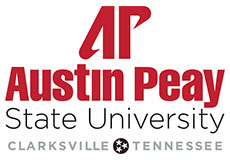 Clarksville, TN – Steven Warth had been reading about fusion energy for years when he walked into his modern physics class at Austin Peay State University (APSU). But it wasn’t until he chose tritium breeding blankets as his class project topic that his casual interest became a clear career path.
Clarksville, TN – Steven Warth had been reading about fusion energy for years when he walked into his modern physics class at Austin Peay State University (APSU). But it wasn’t until he chose tritium breeding blankets as his class project topic that his casual interest became a clear career path.
“I’ve been fascinated with fusion energy forever,” said Warth, now a senior in Austin Peay State University’s engineering physics program. “But that project really got me thinking seriously about the problems that need solving.”
Over the summer, thinking about those problems took Warth to Oak Ridge National Laboratory, where he was one of the first Austin Peay State University students ever chosen for the prestigious and highly selective Science Undergraduate Laboratory Internship (SULI) program.
Getting on the List
Unlike the typical undergraduate scramble for research opportunities, Warth’s path to Oak Ridge was surprisingly direct. For his class presentation in modern physics, Warth was able to leverage contacts within the APSU physics department for aid from an Oak Ridge researcher. His work impressed, and soon he found himself on the Fusion Energy Division’s watch list for promising students.
“I was put in contact with Monica Gehrig, a researcher there, through one of Dr. [Eugene] Donev’s former students,” Warth said. “She helped me with that class project, and afterward put me on their list of potential students to work with.”
When SULI applications opened, Warth was among the first contacted for the opportunity. His combination of genuine interest, prior knowledge, and clear focus made him exactly the type of student Oak Ridge was seeking for its competitive summer program.
“I think it was the same day that mentors were able to send out applications,” he said. “I was almost immediately picked up.”
Fusion School and Finding His Footing
Warth’s Oak Ridge experience began not at the laboratory itself, but at the University of Tennessee’s nuclear engineering department. All fusion division interns spent their first week in an intensive fusion school — eight hours daily of lectures covering everything from plasma physics to reactor economics.
“My hand was hurting a lot by that point from all the note-taking,” Warth said. “I’m ashamed to say I was falling asleep at certain points, but I think we all were. Eight hours a day for a week is a lot.”
The crash course proved essential preparation for the work ahead. Warth’s project involved developing faster computational methods for simulating liquid metal flows in fusion reactors — work that required understanding both the underlying physics and the engineering challenges of making fusion power practical.
Once at Oak Ridge proper, Warth found himself in a different world from typical undergraduate research. This was not about learning techniques or following established protocols. His mentors expected him to tackle genuine research problems with real implications for fusion energy development.
Warth spent his days developing mathematical approximations that could speed up computer simulations from 16 hours to 30 minutes — work that could eventually help engineers design better reactor components and drastically reduce the time needed to compute the flows.
“We’re trying to solve the computational time problem,” he said. “If you want to design these systems, you need to be able to run the math a lot faster than we can right now.”
In August, Warth and his fellow interns attended the Nuclear Occupation Workshop (NOW) Conference in Knoxville, hearing from some of the state’s top nuclear engineers and meeting with representatives from Type 1 Energy, which built the first fusion reactor in the state.
Beyond the Science
What struck Warth most about Oak Ridge wasn’t just the cutting-edge research, but the environment itself. Walking through facilities with decades of scientific history provided perspective on the significance of the work.
“Because of the history, there are a lot of high expectations even for the interns,” he said. “But the mentors do a great job trying to grow you as a student and person.”
This was evident when Warth had to briefly leave Oak Ridge to present some of his other research at the American Society for Engineering Education Conference in Montreal in June, a commitment he was encouraged to keep by his mentors.
This November, Warth will return to the University of Tennessee — not as a student, but as a presenter at the International Symposium on Fusion Nuclear Technology in Knoxville. The opportunity to present his Oak Ridge research at the international conference represents recognition that his summer work contributed meaningfully to the field.
“There’s a few more figures I’d like to change out on the poster,” he said, already thinking about improvements. “We have a little bit more data that we could add now.”
The presentation is the next step in a journey that began with curiosity in a physics classroom and led to contributing to one of science’s biggest challenges. For Warth, it was a confirmation that sometimes the best career paths are the ones you see clearly from the start.
“It was probably one of the most enjoyable summers I’ve had in a long time,” he said. “I got to spend a lot of time doing stuff that I really was interested in.”
For Austin Peay State University’s engineering physics program, Warth’s success — and that of fellow student Ross Rodriguez, who also spent the summer at Oak Ridge — demonstrates that a university doesn’t have to be an R1 institution to prepare students to compete at the highest levels of scientific research.“Because it’s smaller, there’s a lot more one-on-one experience as an undergraduate here,” Warth said. “Faculty are very willing to work with you, especially if you show you’re interested.”
As Warth prepares for his post-graduation career, his Oak Ridge experience has already opened doors for future Austin Peay State University students interested in national laboratory research. More importantly, his work contributes to solving the energy challenges that could define the next century of human progress.
About the Austin Peay State University College of STEM
The Austin Peay State University College of Science, Technology, Engineering & Mathematics (STEM) provides studies for students in the areas of agriculture, astronomy, aviation sciences, biology, chemistry, computer science, earth and environmental sciences, engineering physics, engineering technology, information technology, mathematics, medical laboratory sciences, radiologic sciences and physics.
Our outstanding, discipline-based programs are student-centered and designed to prepare students for responsible positions at all levels of research, industry, education, medicine and government.
About the Science Undergraduate Laboratory Internships (SULI) Program
The Science Undergraduate Laboratory Internships (SULI) program of the U.S. Department of Energy (DOE) Office of Science encourages undergraduate students to pursue science, technology, engineering, and mathematics (STEM) careers by providing research experiences at 17 DOE laboratories and facilities.
Students perform research under the guidance of laboratory staff scientists or engineers on projects supporting the DOE mission. The SULI program is sponsored and managed by the DOE Office of Science’s Office of Workforce Development for Teachers and Scientists (WDTS) in collaboration with the DOE laboratories/facilities.



